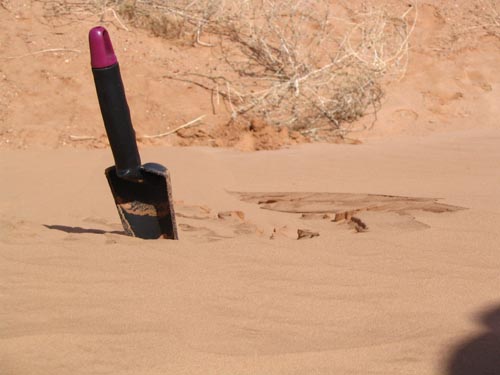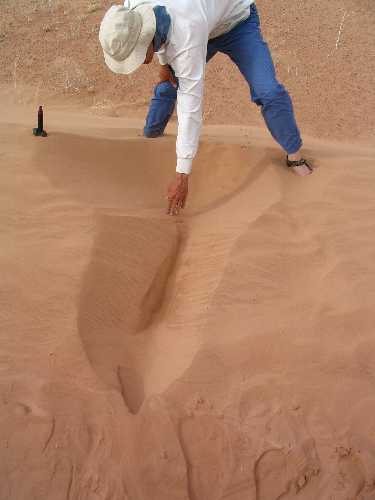Two Weeks in the Life of an Active Sand Dune
Observations of a Utah dune in the spring of 2004
|
This web page describes observations of a sand dune in Utah during a
day of strong wind (including video clips) and of the same dune prior to and
after the strong wind day. Most interesting are the video clips.
|
|
Higher resolution (~300K) versions of most images on this page can be viewed by
clicking on the image.
|
April 26 (moist sand)
|
Photo 1, 2. Here's what the dune looked like before we started digging.
The dune is about 2.5m high, and faces northeast. The sand was moist from steady rain
the previous day. The trowel in the photo is 30cm long, with a 15cm handle.
|


|
Photo 2b. Below is a close-up of the top-left (east) of the avalanche
area, viewed from the brink looking down. The trowel is for scale and
did not disturb the sand. Based on the relief in that area, the sand
was quite over-steepened before it avalanched. The 'pivot point' (the
point at which the level of the resting sand matches the level of
neighbouring un-avalanched sand) is only about 50cm from the head of the
avalanche area. Perhaps a bulge of sand accumulated in moist
conditions and then later lost cohesion as it dried. Vertical wind-ripples
visible on the dune face imply wind was previously blowing across the dune
face, parallel to the crest (perhaps slightly over the crest, depositing the
material that subsequently avalanched).
|

|
Photo 3, 4. The neighbourhood of the dune.
|


|
Photo 5, 6. The photo
below-left shows the back wall of a trench dug at the top
of the dune, windward from the crest. The top 20cm or so of sand
resisted being undermined as dry sand beneath it was removed.
The tip of the trowel is visible in the trench in the photo on
the right.
|


|
Photo 7, 8. Even 'low impact' walking up the dune face caused the moist surface layer
to shift slightly, opening up a fissure at the crestline (below, left).
Wind-ripples on the lee face and dune top indicated wind from a
direction parallel to the brink,
and sand had accumulated on the upwind side of a tumbleweed at the
base of the dune (below, right).
|


|
Photo 9, 10. Sand along the brink appears as if it was eroded while
moist, perhaps by wind along the brink. Perhaps the
rough patch in photo 9 was caused by raindrop impressions (click
on any photo to view with higher resolution).
|


April 28 (high wind!)
Great luck! While still in the area, a 'high wind warning' was issued,
with forecasted winds of 50 mph and gusts to 70 mph (good for sand dune
observing, but not good for some other things -- the next day, the news
reported trucks overturned, trees uprooted, and roofs lifted).
Photo 11, 12. Here's what it looked like at 2:30pm when we arrived; sand
had covered
most of the digging of our previous visit. Below right, airborne sand
is visible downwind of the crest. The wind was strong, fairly steady,
and almost directly perpendicular to the dune face.
|


|
Photo 15. Wind on the top of the dune was strong and steady, moving sand
at high
speed near the surface. The region where we had dug a trench and pits
on Apr26 was being eroded, though they were still visible in the
'wood grain' below. The wood grain pattern implies that the layers
seen on Apr26 at the back wall of the crest trench (photo 5)
were a cross-section of wind-ripple deposits.
|

|
Black specks in the photos above are
plants that were scattered all over
the dune. They look like radish or alfalfa sprouts, and were being
uprooted as sand eroded from around their base. Their desicated leaves
and seed cases were blowing in the wind, and became very good indicators
of calm zones, marked by their accumulation. Without that light organic
material, it would have been far from obvious that there could be calm
zones on such a windy day, when it was difficult at times to even stand.
Photo 16. The trench in the photo below
was dug that day; the Apr26 crest is probably where the moist sand ends.
It would have been interesting to see what layering, if any, was present in the
dry sand between the old crest (end of moist sand) and the new brink,
but conditions weren't great for examining that (the sand would have had
to be moistened, etc, and that area near the brink is one of maximum
sand blasting!). Presumably the top lee face is advancing dune by a cycle of
grainfall and avalanching.
|

|
Photo 17. On the dune top, it appeared as if the wind was removing a 10cm
layer of dry sand, down to the more resistant underlying moist sand (but it could also have been dry sand migrating across the
better-held moist sand).
The photos below show sand travelling across a region of bare moist sand
and then hitting a jump' of dry sand, then continuing on.
Note the accumulation of sprouts just downwind of the crest of the 'jump',
indicating a calm zone. The 'jump' moved slowly downwind, at about 10 or
20 cm/hr. This area was a few meters
upwind of the dune brink, and about 2m west of the Apr26 trench area.
|

|
Photo 18. Below the 'jump' is aligned with the brink of the dune.
It wasn't clear whether the jump was stable there or would 'go over
the brink' and
become similar to the flat brink of photo 17 above (located immediately
behind the photographer when this shot was taken).
|

|
Photo 19. About an hour later, one of the eroding regions on the dune
top developed a scalloped edge. Note the small calm zones within each
hook, on the lee faces (best viewed at high resolution; click on the image).
|

|
Photo 20. Most sand blowing over the brink seemed to fall within a meter or
two of the brink, but judging by accumulations, some was carried into the
interdune area. Note the accumulation of organic material at the toe
of the lee face, and on the lee face -- both were relatively calm areas
(buffeted by occasional turbulence).
|

|
Generally there was a slow avalanche in progress somewhere on the dune face
at any moment. The lazy/mellow avalanching gave the impression
that the dune face never got much steeper than the angle of repose.
While standing in the interdune area about 2m meters downwind of the
dune toe, the wind was turbulent -- sharp puffs separated by relative calm, at a
frequency in the order of a few seconds. This was in stark contrast to the
steady howl when standing on the dune. Sand gently rained down in the
interdune area, whereas my ankles were sandblasted while standing on the
dune.
While crouching on 'Teva' sandals to examine the sprouts, I noticed my
finger near the sand surface felt like it was being struck by a small pebble every second or
so. I soon realized I was feeling the discharge
of static electricity! Evidently the Teva sandals insulated me, and there was enough charge built
up by the impacting sand grains upon my ankles and legs to discharge across a gap of about
5mm once per second or so. I was wearing synthetic long pants; see photo 22. Subsequently,
I learned that saltating sand grains are known to carry an electrostatic charge, developed
probably by friction between grains of differing sizes.
Video clips. Fortunately the digital camera we had (Canon A75)
can record video clips. Click on the link below to see (and hear!) the dune
in action.
Highlights: The path of sand blowing over the brink; eddies traversing
the lee face; the 'jumps'; sand circulating in and out of one of
the Apr26 excavations; the high-energy environment.
Video clips of sand movement in high winds
Eddies occasionally traverse the dune face, but generally not much
disturbs the soft grainfall deposits and tumbleweeds at the toe of the
dune (photo 20, above).
|
May 10 (days after
the high wind)
|
We were able, only briefly, to visit the dune again two weeks later.
Photo 21, 22. 'Dry sand' seems to have filled in behind the center-brink,
approximately where the 'jump' was of photo 18. Photo 22 shows a trench
dug back from the crest. It appears that the lee face advanced about 50cm,
if we take the lee end of the subsurface moist sand (where my hand is pointing)
to be the Apr26 lee face. I'm not sure how to interpret the cohesive
surface sand at the windward end of the trench. No 'jumps' remained; perhaps they are high-wind features that
fill in as the wind subsides. Also perhaps they are a feature dependent on
the presence of the wet sand.
|


|
Photo 23, 24. Here's what some dunes from 190 million years ago look like today
(these images have been flipped horizontally so that the foresets align
with the dune photos above). This Navajo sandstone is in the Paw Hole area,
south of Coyote Buttes.
|


|






















